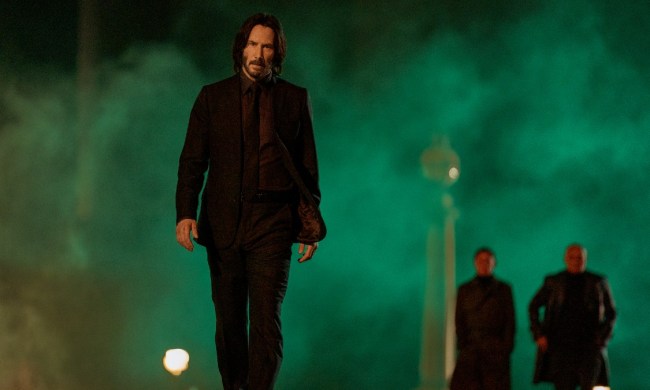In the last decade, the John Wick movies have grown in popularity thanks to their availability on DVD and streaming services. With each successive release, the films have become more adored and commercially successful. While a bulk of that credit goes to lead star Keanu Reeves (who is no stranger to popular action movie franchises), the talented supporting cast, the excellent worldbuilding, and director Chad Stahelski’s unique vision, the incredible action scenes are what people talk about the most.
That’s never been more true than in John Wick: Chapter 4, which sees our hero survive an ambush in a hotel in Osaka, engage in a knife and ax fight in a rainy nightclub in Berlin, and outrun, outlast, and outkill hundreds of bounty hunters across Paris. Digital Trends talked to two members of Chapter 4‘s stunt team, Scott Rogers and Stephen Dunlevy, about their past work histories with Reeves, George Miller, and Baz Luhrmann, how they pulled off that insane chase scene at the Arc de Triomphe, and whether or not Reeves is as nice of a guy as everyone thinks he is.
Note: This article includes spoilers for John Wick: Chapter 4. This interview has been edited for clarity.
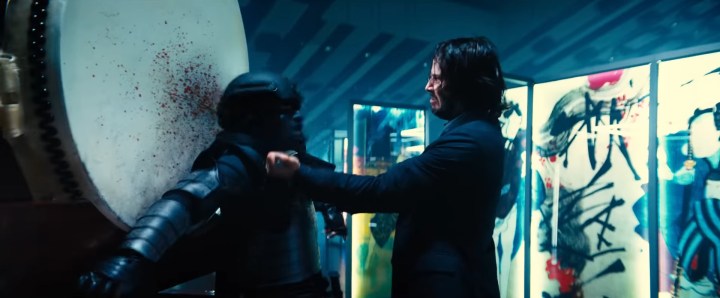
Digital Trends: Both of you have worked on previous John Wick movies in the past. What made you want to come back for John Wick: Chapter 4?
Scott Rogers: Who would in their right mind turn down the opportunity to work on a John Wick movie?
Stephen Dunlevy: I worked on John Wick: Chapter 2 and Chapter 3; Scott coordinated Chapter 3 as well. It’s the pinnacle of the stunt industry. I turned down other movies to work on the John Wick franchise, and I’d do it again.
Scott, you’ve worked with Keanu as far back as 2005’s Constantine, correct?
Rogers: Yeah, I got to work with him a little bit on Constantine. And then I basically did the last three John Wick movies with him.
You’ve had a lot of experience with Keanu then. Can you tell me what it’s like working with him both then and now?
Rogers: He’s extraordinary. He’s everything that the internet thinks he is: kind, generous, and is never mean to anybody. He’ll be mean to himself. He’ll kind of yell and be disappointed at himself. But I’ve never seen him turn it on anyone else.
He is always working hard. The guy shows up on time, all the time. I’ve had the fortunate opportunity to work with a lot of big actors in my career, and he’s far and away one of the best.
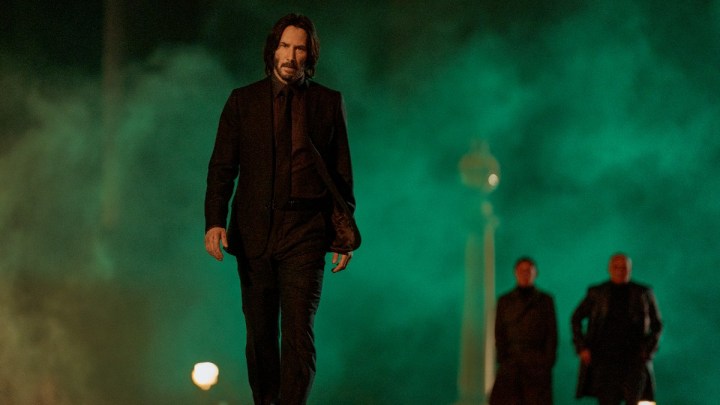
Stephen, you worked with a lot of different directors like Baz Luhrmann (on Australia) and George Miller (on Mad Max: Fury Road and many others). What is it like working with a director like Chad Stahelski versus George or Baz?
Dunlevy: I’ve been very lucky to work with all three because they are highly respected in the industry. They are all visionaries in their own unique way. With Fury Road, George created a modern vision of what a postapocalyptic world looks like. And then you have Chad, who reenvisioned what it meant to do action with John Wick.
I’ve been very fortunate to see Chad grow as a director and expand the world of John Wick from film to film. With George, that template was in place since the ’70s with the original Mad Max. There’s a great similarity between all three of them in that they want to do as much live action as they can and get the actors to do as much as possible without relying too much on CGI.
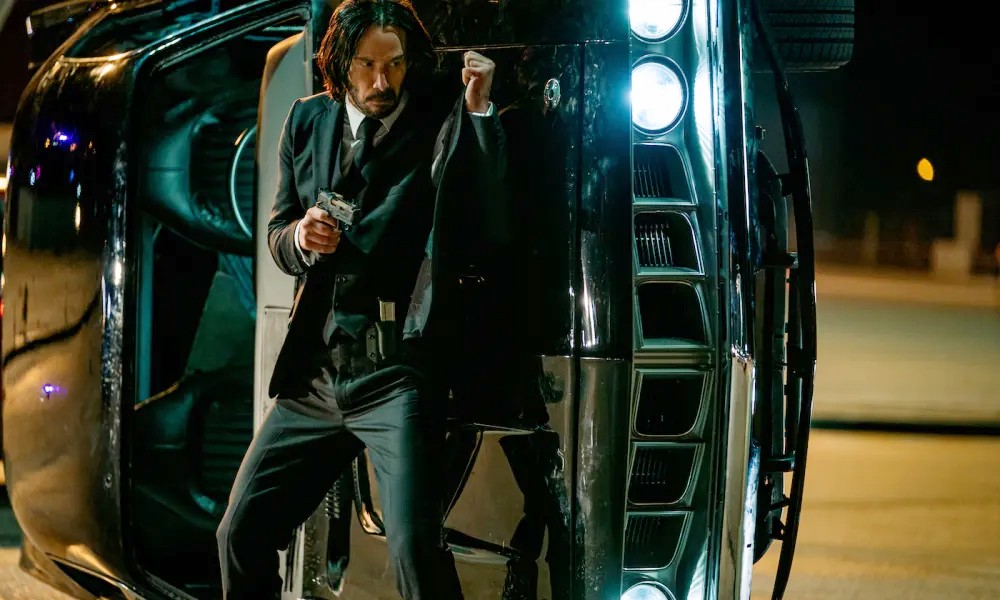
Already, people are claiming that John Wick: Chapter 4 has some of the best action scenes ever put on film. Let’s talk about one of them: the Arc de Triomphe chase scene, which ends up with John fighting bad guys in nighttime rush hour traffic. This has to be one of the most unbelievably insane action scenes of all time. How the hell did you do it? And are you guys OK?
Rogers: [Laughs] I’m fine. I didn’t get hit by any cars. That was a challenging scene to do. It was like what we did with the horse sequence in John Wick: Chapter 3. I developed that sequence with Dan Prescott, and as we were scouting locations in New York City, Chad said, “I want to set John riding the horse under this elevated train.” Now, that’s just the worst place you can put a horse, and we told Chad he couldn’t do it. His response was simply, “This is where I want to do it.”
The same thing happened with the Arc de Triomphe sequence in Chapter 4. He wanted to film an action scene in the middle of the street with cars rushing past everyone. Chad is relentless. One of the things that makes him so extraordinary as a filmmaker is he used to be a fighter. And a fighter doesn’t go into the ring and punch the guy hard enough to win. He punches a guy as hard as he physically can. And that’s how Chad directs. He doesn’t do it hard enough to make a good movie. He does it as hard as he can. And if you’re not ready to work as hard as you can, you shouldn’t work on John Wick movies.
That’s how he approached that scene. Chad wanted to hit a certain amount of people with cars, so Stephen and I had to figure out how many people can you hit with cars without taking each one of them to the hospital. We want to do these spectacular stunts but without losing sight of the reality of it all. How do we keep all of this grounded in the John Wick universe? What helped us with that was that Keanu did a lot of the stunt work, with long takes within the scene.
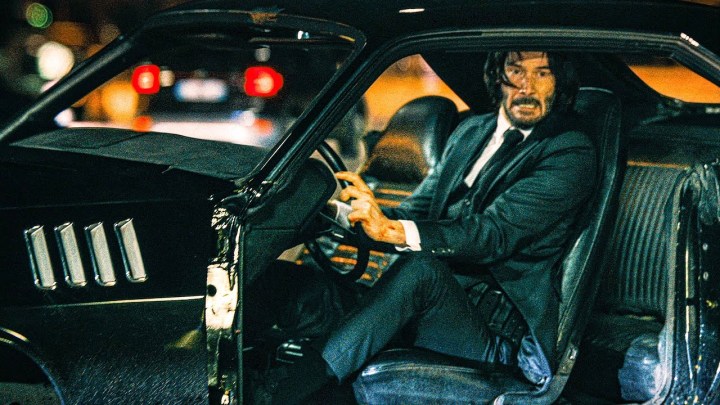
We also had to develop a different way of shooting it because a car armed with a camera mount couldn’t keep up with the action that was scripted. The car was too unwieldy, so it couldn’t be outside the Arc’s circle and then drive through it seamlessly like it was supposed to.
So we brought in a drone. We spent a week developing shots with just a drone, and we did it with Tanner Foust to train Keanu to drive the car. And Tanner would do the drive and we would map it all out, and then we would throw Keanu in and we would train some more. Keanu is known for his work ethic, so he’d come in on his days off, and we’d spend two or three hours in the car trying to nail the choreography down.

Let’s fast-forward to the last part of the action scene in Paris, where you have John’s slow ascension on those famous 222 steps to the Basilica of the Sacred Heart of Paris. This is done twice: John battles his way to the top, and then is pushed down to the bottom, where he has to start all over again. How did you approach this sequence with the knowledge that you’d have to do it twice?
Dunlevy: That scene was tricky because it’s one of those sequences you need to build up to. You can’t throw everything at it to begin with because you need that gradual buildup of John going up the stairs once and then coming all the way back down. And our double legitimately fell all the way down those stairs. That’s him falling down every single step, all the way, more than once.
The second ascension is obviously different because you have Donnie’s character, Caine, joining John and the increased pressure of time winding down. The thing with John Wick is that he’s always trying to get somewhere or to get something, so we need him climbing up those stairs to get to the top. Since he does it one little rung at a time, that’s how we planned it out. We broke up that 222-step staircase into sections and made them each their own thing. Then we built on those sections until it became a cohesive sequence.
I would be remiss not to ask about the Berlin nightclub scene when John goes to assassinate Killa, played by Scott Adkins. It’s quite different from the Paris scene, which is largely outdoors. The nightclub is an enclosed space, albeit with many levels, and also has water dropping down in the middle of it, which creates slick surfaces. Also, this fight is largely a gun-free fight, with knives and axes now in play. How did you set up that scene?
Rogers: We had to set up that scene many months in advance. Kevin [Kavanagh], the production designer, developed this incredible set, right? And the set is covered with all this rain. But what a lot of people don’t realize, the rain has to go somewhere; it can’t just remain on the ground. You get these large sheets of water pouring down on Keanu, Scott, and the extras, but it has to dissipate so you can keep moving and not form a puddle. So Kevin developed a floor that had enough drains for all the actors and stunt people to perform on without slipping too much.
The beauty of the John Wick franchise, and particularly Chapter 4, is that the guns have to go away because if you want to have a knife fight, you can’t have guns because then, it’s a gunfight. That’s part of Chad’s storytelling magic. You know how some directors let their performers have different levels in their performances? Chad does the same thing with action.
So, in previous John Wick movies, we’ve done a car thing, we’ve done a horse thing, we’ve done a bike thing, and now we’re doing a battle where John Wick wields an ax in a rain-soaked nightclub in Berlin. [Laughs] And at the end of the day, Chad makes a movie that he wants to see. And luckily for all of us, we like to see those movies that he likes to see.
John Wick: Chapter 4 is now playing in theaters. For John Wick fans, read John Wick: Chapter 4’s ending explained, John Wick: Chapter 4’s best scene, 5 reasons why John Wick is the best action movie ever, and Does John Wick die at the end of John Wick: Chapter 4?



